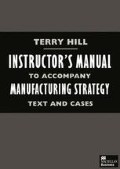Abstract
Manufacturing is inherently a complex task and managing this complexity is a key corporate role. The complexity involved, however, does not emanate from the nature of the individual tasks that the job comprises. In all but highly technical, special product market segments, it is not difficult to cope with the technology of the product or process. In most situations, the process technology and wherewithal to make the product involved have been purchased from outside, with appropriate engineering and technical know-how provided inside to support the manufacturing requirement and underpin any necessary development. In a similar way, product design and the associated technology falls under the auspices of the customer and/or design function. Hence, neither process nor product technologies are generally difficult to understand or manage from the viewpoint of the manufacturing function.
Preview
Unable to display preview. Download preview PDF.
Notes
Brought to prominence in E. F. Schumacher’s book, Small Is Beautiful: Economics as if People Mattered, New York: Harper & Row, 1975.
This concept was first introduced in an article by T J. Hill and R. M. G. Duke-Woolley, ‘Progression or Regression in Facilities Focus’, Strategic Management Journal, 1983, 4(2): 109–21.
Copyright information
© 2000 Terry Hill
About this chapter
Cite this chapter
Hill, T. (2000). Focused Manufacturing — Principles and Concepts. In: Manufacturing Strategy. Palgrave, London. https://doi.org/10.1007/978-1-349-14018-3_7
Download citation
DOI: https://doi.org/10.1007/978-1-349-14018-3_7
Publisher Name: Palgrave, London
Print ISBN: 978-0-333-65740-9
Online ISBN: 978-1-349-14018-3
eBook Packages: Palgrave Business & Management CollectionBusiness and Management (R0)

